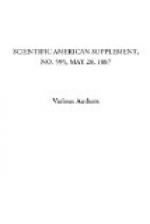[Illustration]
The substitution of the lamp, L, for L’ is almost instantaneous. It can scarcely be perceived. It goes without saying that such an arrangement of automatic commutation is applicable to lamps with two or more filaments of which only one is to be lighted at a time. The apparatus costs little, and can be made as ornamental as desired. No exaggeration is indulged in if we pronounce it simple and ingenious. It may be used in a great variety of eases. The diameter of the wire is 55/100 (22 mm.), its length eighteen meters (60 feet), its resistance one ohm; 3/4 ampere is needed to work it, and less than a watt is absorbed by it.—Electricite.
* * * * *
DEFINITIONS AND DESIGNATIONS IN ELECTROTECHNICS.
We may discourse for some time to come upon the uniformity of electric language, for universal agreement is far from being established. An important step toward the unity of this language was taken in 1881 by the congress of Paris, which rendered the use of the C.G.S. system definitive and universal. This labor was completed in 1884 by the meeting of a new congress at Paris, at which a definition of the C.G.S. and practical units was distinctly decided upon. That the unit of light defined by the congress has not rapidly come into favor is due to the fact that its practical realization is not within everybody’s reach.
The work of unification should not come to a standstill on so good a road. How many times in scientific works or in practical applications do we find the same physical magnitude designated by different names, or even the use of the same expression to designate entirely different things!
The result is an increase of difficulties and confusions, not only for persons not thoroughly initiated into these notions, but also for adepts, even, in this new branch of the engineer’s art. The effects of such confusion make themselves still further felt in the reading of foreign publications. Thus, for example, in Germany that part of a dynamo electric machine that is called in France the induit (armature) is sometimes styled anker, and more rarely armatur. The north pole of a freely suspended magnetized needle is the one that points toward the geographical north of the earth. In France, and by some English authors, this pole is called the south one. Among electricians of the same country, what by one is called electro-motive force is by another styled difference of potential, by a third tension, and even difference of tension.




